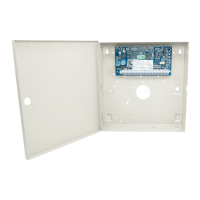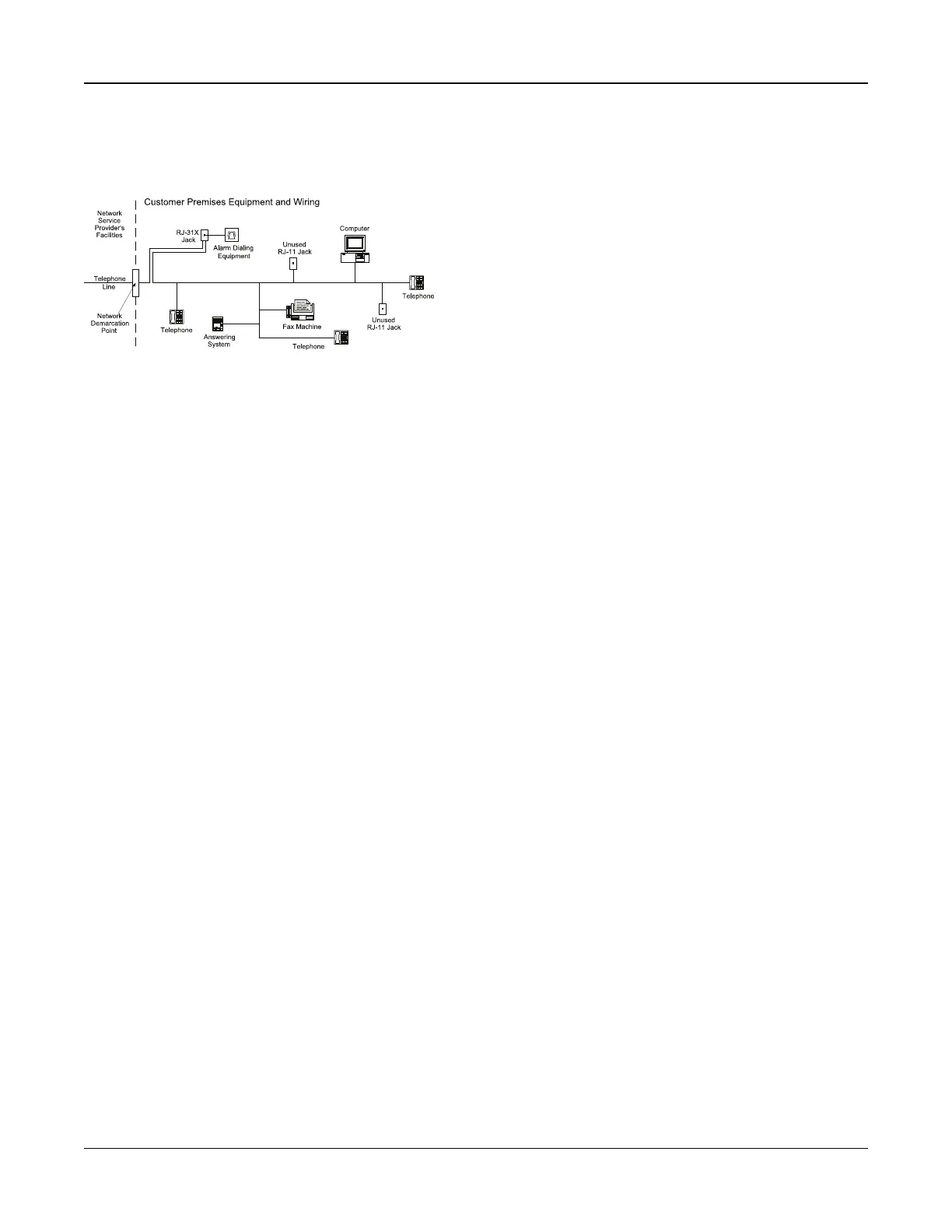Appendix 4: Regulatory Approvals
Alarm dialling equipment must be able to seize the telephone line and place a call in an emergency situation, even if other equipment (telephone,
answering system, computer modem, etc.) already has the telephone line in use. To do so, alarm dialling equipment must be connected to a
properly installed RJ-31X jack that is electrically in series with and ahead of all other equipment attached to the same telephone line. Proper
installation is depicted in the figure below. Consult your telephone company or a qualified installer if you have any questions concerning these
instructions or about installing the RJ-31X jack and alarm dialling equipment for you.
INDUSTRY CANADA STATEMENT
NOTICE: This Equipment, HS2016/HS2032/HS2064/HS2128, meets the applicable Industry Canada Terminal Equipment Technical
Specifications. This is confirmed by the registration number. The abbreviation, IC, before the registration number signifies that registration was
performed based on a Declaration of Conformity indicating that Industry Canada technical specifications were met. It does not imply that Industry
Canada approved the equipment.
NOTICE: The Ringer Equivalence Number (REN) for this terminal equipment is 0.1. The REN assigned to each terminal equipment provides an
indication of the maximum number of terminals allowed to be connected to a telephone interface. The termination on an interface may consist of
any combination of devices subject only to the requirement that the sum of the Ringer Equivalence Numbers of alldevices does not exceed five.
L’indice d’équivalence de la sonnerie (IES) sert à indiquer le nombre maximal de terminaux qui peuvent être raccordés à une interface
téléphonique. La terminaison d’une interface peut consister en une combinaison quelconque de dispositifs, à la seule condition que la somme
d’indices d’équivalence de la sonnerie de tous les dispositifs n’excède pas 5.
Certification Number:
IC: 160A-HS2128
This Class B digital apparatus complies with Canadian ICES-003.
Cet appareil numérique de la classe B est conforme à la norme NMB-003 du Canada.
UL/ULC Installations
This product (HS2016/HS2032/HS2064/HS2128) has been tested and found in compliance with the following standards:
l UL1610 Central-Station Burglar-Alarm Units
l UL365 Police Station Connected Burglar Alarm Units and Systems
l UL1023 Household Burglar-Alarm System Units
l UL985 Household Fire Warning System Units
l UL1635 Digital Alarm Communicator System Units
l UL1637 Home Health Care Signaling Equipment
l ULC-S304-06 Signal Receiving Centre & Premise Burglar Alarm Control Units
l ULC-S559-04 Equipment for Fire Signal Receiving Centers and Systems
l ULC-S545-02 Residential Fire Warning System Control Units
l ORD-C1023-1974 Household Burglar-Alarm System Units
This product has also been tested and found in compliance with the ANSI/SIA CP-01-2010 Control Panel Standard – Features for False Alarm Reduction.
This product is UL/ULC listed under the following categories:
l AMCX/AMCXC Central Stations Alarm Units
l APAW Police-station-connected Alarm Units
l DAYRC Central Station Fire Alarm System Units
l UTOU/UTOUC Control Units and Accessories, Household System Type
l NBSX/NBSXC Household Burglar Alarm System Units
l AMTB Control Panels, SIA False Alarm Reduction
The product is labeled with the UL and ULC listing marks along with the SIA CP-01 compliance statement (Also Classified in accordance with SIA-CP-01 Standard) as
proof of compliance with the above mentioned standards. For further information on this product’s listings please also refer to the official listing guides published at the
UL web site (www.ul.com) under Online Directions Section.
UL/ULC Residential Fire and Burglary Installations:
For ULC Installations refer to the Standard for the Installation of Residential Fire Warning Systems, CAN/ULC-S540.
l All burglary-type zones shall be configured with SEOL or DEOL configuration. Use model EOLR-2
l (refer to section [002], bit 10 or 11 shall be ON)
l Use at least one PG9926/ PG9916 Smoke Detector for Fire Installations (section [001], fire zone shall be programmed as type 025)
l The entry delay shall not exceed 45 seconds (see section [005])
l The exit delay shall not exceed 60 seconds (refer to section [005])
l The minimum Bell Time-out is 4 minutes (refer to section [005])
- 205 -

